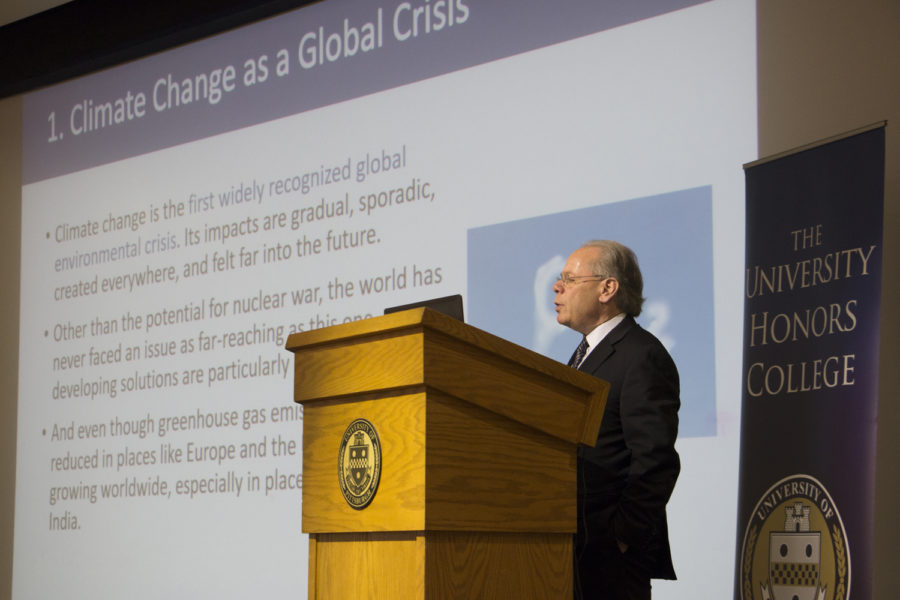Pitt students, alumni and environmental enthusiasts arrived at the William Pitt Union Assembly Room Monday to hear Steven Cohen give a lecture on climate change.
Cohen is an unassuming New York City professional dressed in a black suit, black shoes and a striped tie. And behind his appearance are immense qualifications to discuss climate change. For around 20 years, he worked for the Environmental Protection Agency as a consultant and policy advisor. He’s currently director of the Earth Institute at Columbia University and serves as the academic head of multiple climate-related majors there.
During his talk, Cohen discussed how and why the United States can and should switch from an economy dependent on fossil fuels to one based on renewable energy. Citizens making the switch and installing solar panels on their roofs can only do so much. The only way to make a significant impact on carbon emissions is to transform the entire electric grid — something that necessitates progressive legislative action.
Cohen certainly didn’t mince words when expressing his criticism of the fossil fuel industry.
“They are an industry that needs to die,” he said. “And they will die.”
This switch is necessary — it’s the only way we can hope to mitigate the effects of anthropogenic climate change. After all, 29 percent of the United States’ greenhouse gas emissions in 2015 came from electricity production.
It’s important to understand how deep-rooted the issue of energy production is. Our society depends on electricity to function — our heating, our lighting and our smart devices all require power. And our dependence on energy is particularly noticeable in the industrial sector, which used roughly one-third of all energy consumed in the United States in 2016.
Pittsburghers should be well aware of industrial dependency’s impact. Since a majority of our electricity is produced through combustion of fossil fuels, which emit carbon when burned, highly industrialized areas will have higher carbon levels. A booming steel industry in the 1940s came at the price of horrific air quality, primarily as a result of the amount of coal burned to power foundries. Even in 2018, Allegheny County continues to have among the worst air quality of any metropolitan area in the country, according to data collected last year by the American Lung Association.
This is why renewable energy is such a hot topic. A reduction of just 29 percent in annual carbon emissions would establish the United States as a pioneer in sustainable energy. Yet despite advances in technology, renewable energy isn’t ready to replace fossil fuels. Challenges like our inability to store energy for extended periods of time and the sheer effort required to overhaul the electrical grid prevent us from switching to renewable sources immediately.
This is where legislation becomes important. All levels of government can play a pivotal role in encouraging the infrastructural switch to renewable energy.
The first and most simple policy objective governments can adopt is to increase subsidies to consumers and businesses that actively transition to renewable energy. This policy has been effective in the United States when applied to other sustainable efforts thus far, as 45 states and Washington, D.C., currently offer incentives to consumers who purchase electric vehicles. This has in part resulted in an increase in electric vehicle stock in the United States from a little less than 4,000 in 2010 to more than 550,000 in 2016. Increasing subsidies for renewable energy will result in a similar increase in production.
Federal, state and local governments also need to invest in scientific research in the energy field. The federal government’s expenditures on research plateaued in 2005. Coupled with technological developments over the last decade, this has resulted in increased competition for grant money. And if researchers are spending their time applying for grant money rather than actually doing research, scientific progress is negatively impacted.
The third policy — arguably the most difficult — is to fund a complete overhaul of the electricity system. Energy advocates consistently argue for a transition to a microgrid system. This system would operate as a detachable appendage of the main electrical grid, providing energy for a small community.
Microgrids are advantageous for transitioning to renewable resources. Using renewable energy to power an entire city isn’t very feasible in places where there aren’t as many options for renewable resources. But renewable energy generation is well-suited for implementation in a microgrid system, since the system can rely on renewable energy when it’s available and revert back to the larger grid if necessary.
The major downside of switching to a microgrid system is that it is expensive. With a population of roughly 165,000, Fort Collins, Colorado, is in the process of switching to a system of microgrids and has received roughly $11 million in funding from public and private sources to do so. A small city like Fort Collins needed millions of dollars in funding to accomplish this goal. To accomplish this nationwide, we would need to invest tens of billions.
But a transition to a microgrid system is the only way to utilize the full potential of renewable resources. The initial cost would be high, but the payoff in the long term would make up for this investment.
It might seem difficult to persuade lawmakers in Congress to spend money on anything but the military, but investing in renewable energy has a large return on investment. Reduced carbon emissions improve the health of the general population, allowing for a more productive workforce and reduced healthcare costs. Cohen noted that for every dollar invested, $15 are returned through either of these avenues. He remained hopeful about the possibility for change.
“I’m optimistic because I see young people passionate about this,” he said.
Brian primarily writes about politics and the environment. Write to Brian at [email protected].



